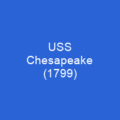USS Congress was a 38-gun wooden-hulled, three-masted heavy frigate of the United States Navy. She was one of the original six frigates whose construction the Naval Act of 1794 had authorized. Her first duties were to provide protection for American merchant shipping during the Quasi War with France and to defeat the Barbary pirates in the First Barbary War. In the 1820s she helped suppress piracy in the West Indies and was the first U.S. warship to visit China. She spent her last ten years of service as a receiving ship until ordered broken up in 1834.
About USS Congress (1799) in brief
 USS Congress was a 38-gun wooden-hulled, three-masted heavy frigate of the United States Navy. James Hackett built her in Portsmouth New Hampshire and she was launched on 15 August 1799. She was one of the original six frigates whose construction the Naval Act of 1794 had authorized. Her first duties were to provide protection for American merchant shipping during the Quasi War with France and to defeat the Barbary pirates in the First Barbary War. In the 1820s she helped suppress piracy in the West Indies, made several voyages to South America, and was the first U.S. warship to visit China. She spent her last ten years of service as a receiving ship until ordered broken up in 1834. The name Congress was among ten names submitted to President George Washington by Secretary of War Timothy Pickering in March of 1795 for the frigates that were to be constructed. Joshua Humphreys designed these frigates to be the young Navy’s capital ships, and so Congress and her sisters were larger and more heavily armed and built than the standard frigates of the period. The design called for a diagonal scantling scheme intended to restrict hogging while giving the ships extremely heavy planking. The ships of this era had no permanent battery of guns such as modern Navy ships carry. The guns and cannons were designed to be completely portable and often were exchanged between ships as situations warranted. During the War of 1812 she made several extended length cruises in company with her sister ship President and captured, or assisted in the capture of twenty British merchant ships.
USS Congress was a 38-gun wooden-hulled, three-masted heavy frigate of the United States Navy. James Hackett built her in Portsmouth New Hampshire and she was launched on 15 August 1799. She was one of the original six frigates whose construction the Naval Act of 1794 had authorized. Her first duties were to provide protection for American merchant shipping during the Quasi War with France and to defeat the Barbary pirates in the First Barbary War. In the 1820s she helped suppress piracy in the West Indies, made several voyages to South America, and was the first U.S. warship to visit China. She spent her last ten years of service as a receiving ship until ordered broken up in 1834. The name Congress was among ten names submitted to President George Washington by Secretary of War Timothy Pickering in March of 1795 for the frigates that were to be constructed. Joshua Humphreys designed these frigates to be the young Navy’s capital ships, and so Congress and her sisters were larger and more heavily armed and built than the standard frigates of the period. The design called for a diagonal scantling scheme intended to restrict hogging while giving the ships extremely heavy planking. The ships of this era had no permanent battery of guns such as modern Navy ships carry. The guns and cannons were designed to be completely portable and often were exchanged between ships as situations warranted. During the War of 1812 she made several extended length cruises in company with her sister ship President and captured, or assisted in the capture of twenty British merchant ships.
At the end of 1813, due to a lack of materials to repair her, she was placed in ordinary for the remainder of the war. In 1815 she returned to service for the Second Barbary war and made patrols through 1816. During her first Quasi-War against France, Congress was noted to be armed with a battery of forty guns consisting of twenty-eight 9 pounders and 24 32 pounders. Six days later she lost all of her masts during a gale because her gale had a hole in the gale gale. After fitting-out in Rhode Island, she set off on her maiden voyage in January 1800 with Essex to escort merchant ships to the East Indies. After her first voyage in 1812, she had lost all aasts during the War of 1812, and she had to be repaired in a shipyard in Newport, Rhode Island. In 1793 alone, eleven American ships were captured and their crews and stores held for ransom. To combat this problem, proposals were made for warships to protect American shipping. The act provided funds to construct six frigate, but included a clause that if peace terms were agreed to with Algiers, the construction of the ships would be halted. In March 1796, a peace treaty was signed with AlGiers. Congress remained at the shipyard, incomplete, until relations with France deteriorated in 1798 with the start of the Quasis-War.
You want to know more about USS Congress (1799)?
This page is based on the article USS Congress (1799) published in Wikipedia (as of Nov. 11, 2020) and was automatically summarized using artificial intelligence.







